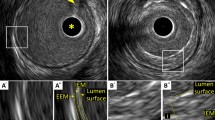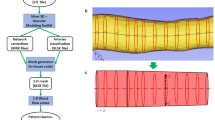Abstract
In this paper, we propose a novel method for three-dimensional (3D) blood vessel modeling. Given the incomplete nature of medical images, a 3D blood vessel model that includes the intima and adventitia cannot be reconstructed with a single medical image. Intravascular ultrasound (IVUS) images are used to obtain detailed intimal and adventitial information. Then, X-ray angiogram images are used to calculate the position and orientation of IVUS images. Combining these medical images can generate a 3D blood vessel model. To visualize a blood vessel via IVUS, a catheter that is attached to a miniaturized ultrasound device is inserted into the blood vessel. The insertion of the catheter deforms the blood vessel. This deformation is reflected in the 3D blood vessel model that is developed from combining IVUS and X-ray angiogram images. To address this problem, we propose a novel method for 3D blood vessel modeling using undeformed intimal and adventitial information from IVUS images. Our proposed method has potential applications in hemodynamic analysis.
Similar content being viewed by others
References
C. G. Caro, T. J. Pedley and W. A. Seed, Mechanics of the Circulation, Cardiovascular Physiology, Medical and Technical Publishers, London (1974).
K. M. Tse, P. Chiu, H. P. Lee and P. Ho, Investigation of hemodynamics in the development of dissecting aneurysm within patient-specific dissecting aneurismal aortas using computational fluid dynamics(CFD) simulations, Journal of Biomechanics, 44 (5) (2001) 827–836.
Y. Qian, J. Liu, K. Itatani, K. Miyaji and M. Umezu, Computational hemodynamic analysis in congenital heart disease: Simulation of the norwood procedure, Annals of Biomedical Engineering, 38 (7) (2010) 2302–2313.
J. Knight, S. Baumuller, V. Kurtcuoglu, M. Turina, J. Turina, U. Schurr, D. Poulikakos, W. Marshall and H. Alkadhi, Long-term follow-up, computed tomography, and computational fluid dynamics of the cabrol procedure, The Journal of Thoracic and Cardiovascular Surgery, 139 (6) (2010) 1602–1608.
H. Younis, M. Kaazempur-Mofrad, R. Chan, A. Isasi, D. Hinton, A. Chau, L. Kim and R. Kamm, Hemodynamics and wall mechanics in human carotid bifurcation and its consequences for atherogenesis: Investigation of inter-individual variation, Biomechanics and Modeling in Mechanobiology, 3 (1) (2004) 17–32.
A. Valencia, F. Munoz, S. Araya, R. Rivera and E. Bravo, Comparison between computational fluid dynamics, fluidstructure interaction and computational structural dynamics predictions of flow induced wall mechanics in an anatomically realistic cerebral aneurysm model, International Journal of Computational Fluid Dynamics, 23 (3) (2009) 649–666.
D. Lesage, E. D. Angelini, I. Bloch and G. Gunka-Lea, A review of 3D vessel lumen segmentation techniques: Models, features and extraction schemes, Medical Image Analysis, 13 (6) (2009) 819–845.
L. Antiga, B. Ene-Iordache and A. Remuzzi, Computational geometry for patient-specific reconstruction and meshing of blood vessels from MR and CT angiography, IEEE Transactions on Medical Imaging, 22 (5) (2003) 674–684.
F. Weichert, M. Wawro, H. Müller and C. Wilke, Registration of biplane angiography and intravascular ultrasound for 3D vessel reconstruction, Methods of Information in Medicine, 43 (4) (2004) 398–402.
S. Paul, D. Anthony, E. N. Steven and E. M. Tuzcu, IVUS MADE EASY, Informa Healthcare (2005).
J. W. Son, Q. Zhang and Y. Choi, Reconstruction of blood vessel model with adventitia from CT and IVUS images for FSI analysis, International Journal of Precision Engineering and Manufacturing, 12 (4) (2013) 643–648.
K. R. Hoffmann, A. Wahle, C. Pellot-Barakat, J. Sklansky and M. Sonka, Biplane X-ray angiograms, intravascular ultrasound, and 3D visualization of coronary vessels, International Journal of Cardiac Imaging, 15 (6) (1999) 495–512.
C. Molina, G. Prause, P. Radeva and M. Sonka, 3-D catheter path reconstruction from biplane angiograms, Medical Imaging, International Society for Optics and Photonics (1998) 504–512.
A. Wahle, G. P. Prause, S. C. DeJong and M. Sonka, Geometrically correct 3-D reconstruction of intravascular ultrasound images by fusion with biplane angiography-methods and validation, IEEE Transactions on Medical Imaging, 18 (8) (1999) 686–699.
G. P. M. Prause, S. C. DeJong, C. R. McKay and M. Sonka, Towards a geometrically correct 3-D reconstruction of tortuous coronary arteries based on biplane angiography and intravascular ultrasound, International Journal of Cardiac Imaging, 13 (6) (1997) 451–462.
L. Antiga, Patient-specific modeling of geometry and blood flow in large arteries, Politecnico di Milano, Dipartimento di Bioingegneria, Italy (2002).
L. Antiga and D. A. Steinman, Robust and objective decomposition and mapping of bifurcating vessels, IEEE Transactions on Medical Imaging, 23 (6) (2004) 704–713.
B. K. P. Horn, Closed-form solution of absolute orientation using quarternions, Journal of Optical Society of America, 4 (4) (1987) 629–642.
P. J. Besl and N. D. McKay, A method for registration of 3-D shapes, IEEE Transactions on Pattern Analysis and Machine Intelligence, 14 (2) (1992) 239–256.
Author information
Authors and Affiliations
Corresponding author
Additional information
Recommended by Associate Editor Won Hyoung Ryu
Jinwon Son is a post doctor of Korea Institute of Science and Technology (KIST), Seoul, Korea. He received his Ph.D. degree in Mechanical Engineering from Chung-Ang University.
Young Choi is a Professor of School of Mechanical Engineering, Chung-Ang University, Seoul, Korea. He received his Ph.D. degree in Mechanical Engineering from Carnegie Mellon University.
Rights and permissions
About this article
Cite this article
Son, J., Lee, W.S., Lee, S. et al. Accurate three-dimensional modeling of blood vessels using computer tomography, intravascular ultrasound, and biplane angiogram images. J Mech Sci Technol 31, 2023–2031 (2017). https://doi.org/10.1007/s12206-017-0352-5
Received:
Revised:
Accepted:
Published:
Issue Date:
DOI: https://doi.org/10.1007/s12206-017-0352-5




